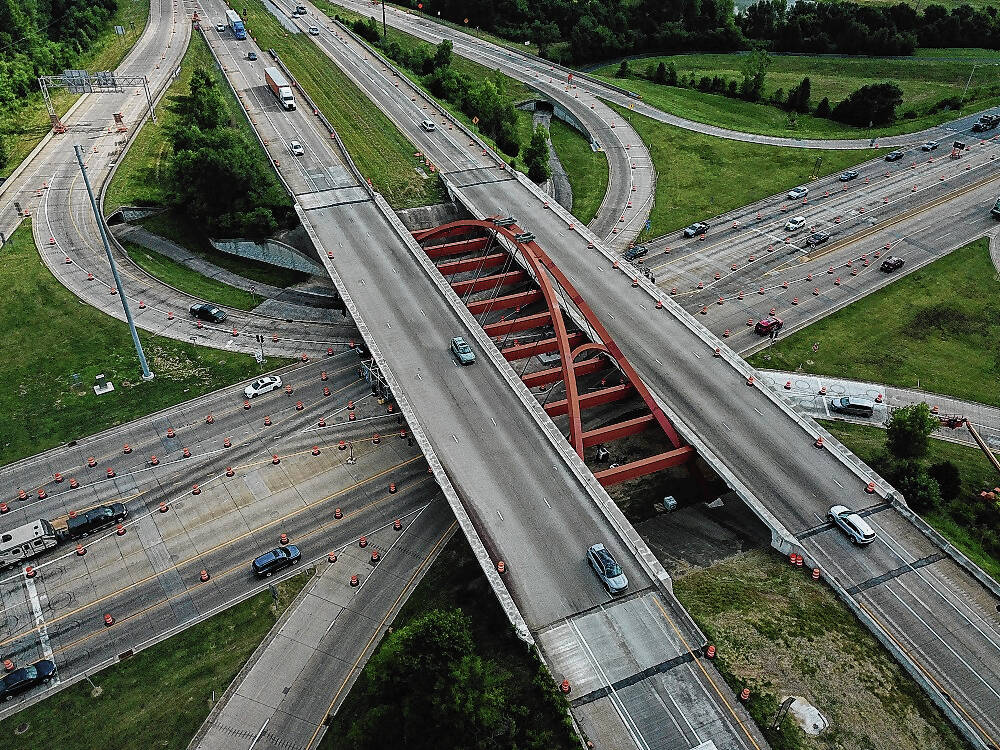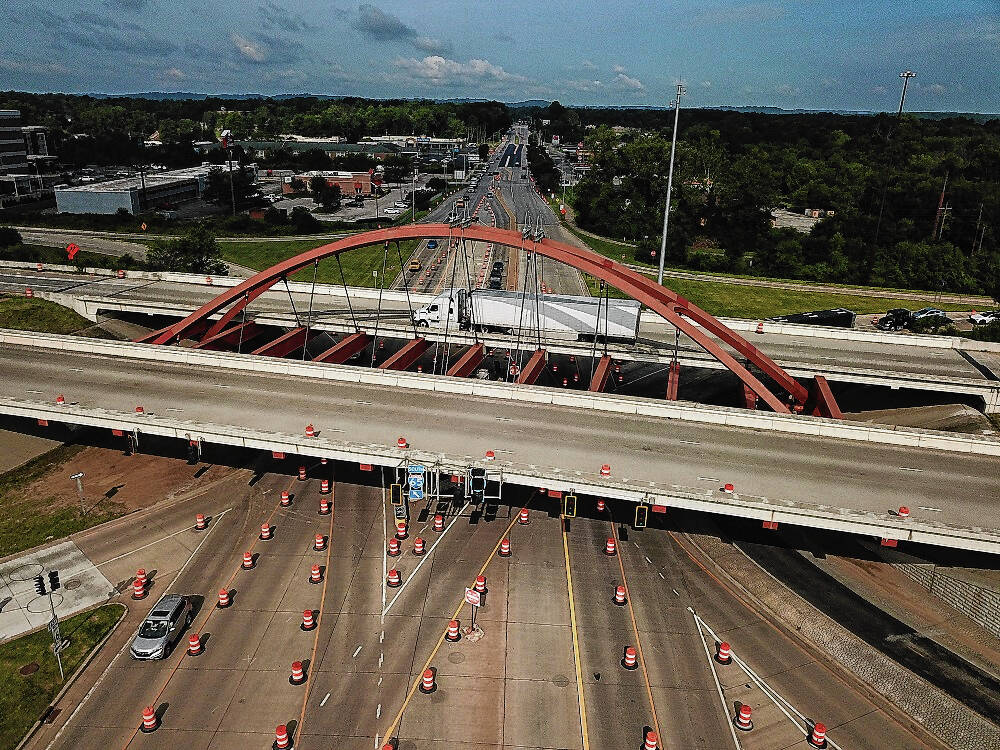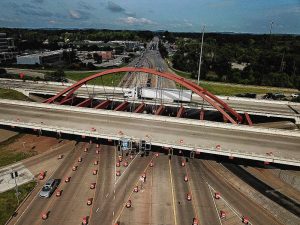
Photo provided In this drone photo provided by INDOT, the iconic bridge that serves as the “gateway” to the front door of Columbus is shown. The cables are visible from the top of the arch moving downward.

Photo provided In this drone photo provided by INDOT, the iconic bridge that serves as the “gateway” to the front door of Columbus is shown. The cables are visible from the top of the arch moving downward.
Next month, it will be exactly 30 years since Columbus residents were given a unique peek into their future, centered on an iconic bridge over State Road 46 at I-65.
On Aug. 13, 1993, an open meeting marked the first time that the $46.5 million Front Door Project was presented to the public. At that early phase, the project’s crowning jewel was the $23 million Gateway Arch Bridge on Interstate 65 over State Road 46 West.
Today, frustrated motorists who find themselves caught in bridge construction-related delays may wonder if lengthy repairs now might be due to the bridge’s unique and unusual design.
In the mid 1990s, leaders of the Front Door Project told J. Muller International of Chicago, the firm that designed the structure, that the bridge must have a “signature design” unique for Columbus, according to a 1998 feature article published by the American Institute of Steel Construction.
Before and after the double-arch bridge opened on Nov. 26, 1996, residents kept hearing or reading that the overpass was one-of-a-kind.
For example, designing engineer Jim Lockwood said “it’s the first time a bridge like this is being built.”
The late Milestone Contractors president John Spangler described the 292-foot long bridge as “something we’ve never done.”
Another leading engineer, Jeffrey Borgsmiller, said “there is really not another (bridge) anywhere else like it, definitely not in the states.”
According to the Indiana Department of Transportation, the 30-year-old bridge was not a matter of style over substance.
“The bridge was designed to the standards in place at that time,” said Natalie Garrett, strategic communications director for INDOT. “The design has been determined to be adequate for the span length, roadway widths and current loads that cross the bridge daily.”
An October 2020 article in Structure Magazine states that cable-stayed structures are “the youngest, fastest-developing and most promising bridge system in the world.”
But it should be noted that all bridge designs, including cable-stayed bridges, are being continuously improved. New decisions are based on the development of high-strength materials and new construction technologies as engineers use modifications of established structural systems and newer sub-systems, according to the magazine.
“INDOT has not built another bridge with this same design,” Garrett said. “While the roadway decks are cantilevered from the cable stays, they limit the possibility of widening the bridge.”
The term “cantilever” means the decks appear to be supported at only one end, much like a balcony extends out from a building.
The reason for the current lengthy work on the bridge is potential corrosion of steel cables, which INDOT says eventually happens to all cable-stayed bridges.
Road salt used for snow and ice removal accumulating for a quarter of a century have been a factor in cable corrosion. However, INDOT engineers for the Seymour district say it is not the main cause of concern.
“The corrosion on the I-65 bridge in Columbus is believed to be a result of moisture that has collected in the cable sheaths over the years that the bridge has been in service,” Garrett said.
That leads to a second and possibly larger concern, the INDOT spokeswoman said. Those cable sheaths obscure the degree of corrosive damage visible to inspectors. Since the corrosion cannot be seen, Garrett said the only choice for state transportation officials is to be overly-cautious.
Undetected cable corrosion can be deadly. In August, 2018, Europe’s first cable-stayed bridge collapsed in Genoa, Italy, killing 39 people. One year later, corroded steel cables snapped on a bridge in eastern Taiwan, killing six and injuring 12. The following year, a bridge with corroded cables loaded with pedestrians collapsed after a NASCAR race in North Carolina, leaving 107 injured.
The temporary structures under the Gateway Arch Bridge were installed late last fall as a precaution while a system of permanent supplemental hanger systems was designed and fabricated. The systems are now being put into place.
Installation is expected to be completed late this month.
 Photo provided In this drone photo provided by INDOT, the iconic bridge that serves as the “gateway” to the front door of Columbus is shown. The cables are visible from the top of the arch moving downward.
Photo provided In this drone photo provided by INDOT, the iconic bridge that serves as the “gateway” to the front door of Columbus is shown. The cables are visible from the top of the arch moving downward.
INDOT and its contractor Force Construction had overnight lane and ramp closures Friday and Saturday at the bridge to complete the installation of the support hangars.
The Front Door Project
In the summer of 1993, the following elements of the Front Door Project were presented to the public for the first time.
- A new, single-point interchange at Interstate 65 and Jonathan Moore Pike to serve as a gateway to the city.
- A new Second Street bridge to carry vehicles into Columbus, while a rehabilitated Tipton bridge will carry traffic out of the city.
- Widening of Jonathan Moore Pike to four lanes west of Interstate 65 to Road 325W.
- Resurfacing and leveling of Jonathan Moore Pike with a grass median and controlled access to commercial areas.
- A frontage road to relieve congestion at the Holiday Inn Conference Center, which was later torn down due to flood damage that occurred in 2008.
- Protected pedestrian and bicycle trails connecting the the People Trails at Mill Race Park.
- Replacement of willow trees and landscaping in the commercial zones east and west of I-65.
- Light poles in the median of Jonathan Moore Pike painted in reflective colors.
Over the next few years, some plans were modified or dropped. 80% of the $46.5 Front Door Project was paid with federal funds, while state and local funds made up 20% of the costs.
